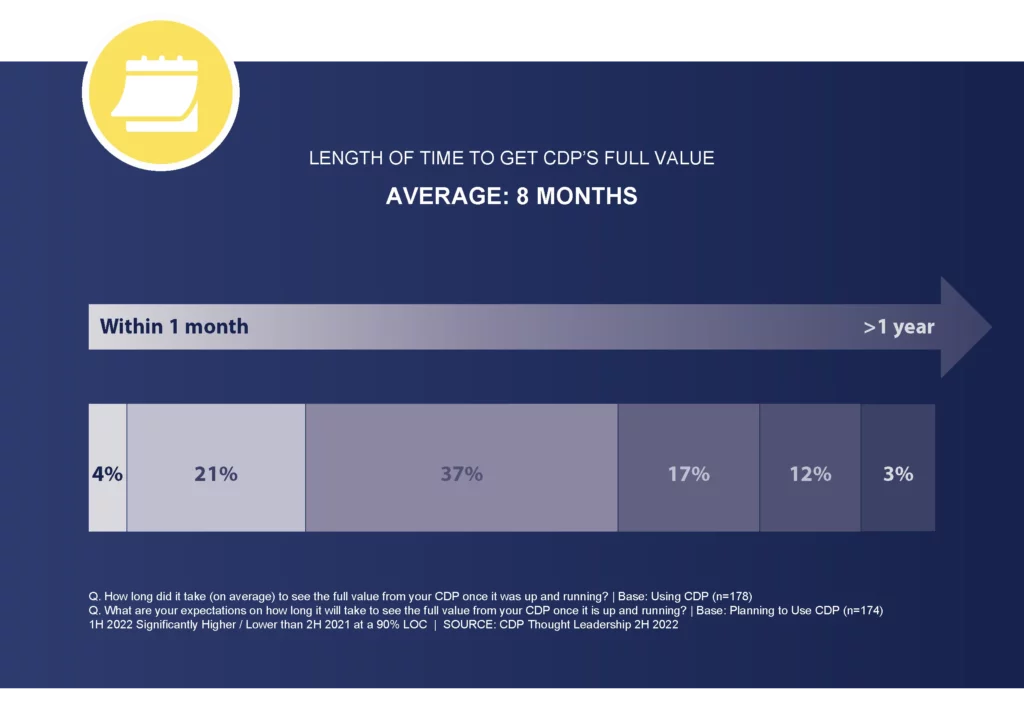In 2024, businesses invested $7.4 billion (£5.9 billion) in CDPs (Customer Data Platforms). However, this is not spread evenly; roughly 30% of businesses don’t yet use a CDP at all, and of those that are, only half think they are getting the maximum possible capability from their chosen platform.
We’ve examined the challenges surrounding CDP adoption and some of the myths that persist as the technology turns 12 years old.
Challenges
Challenge 1: Lack of proper integration
The central premise of a CDP certainly sounds appealing: all your customer data is in one place, creating a complete view of every customer.
Unfortunately, not every software that calls itself a CDP actually delivers this. Some simply create yet another silo in the business, holding data in a separate system and making integration harder rather than easier.
Challenge 2: Resistance to change
12 years may be aeons in the world of marketing technology, but it’s not much compared to how long many businesses have been doing “just fine” without a CDP.
If the benefits are not properly explained, adding a CDP to your tech stack can be seen as just another process the data has to go through before you can use it.
However, data from Advertiser Perceptions shows that the average time it takes for CDP value to become obvious is only 8 months from deployment.
Challenge 3: Dodgy data
Every so often, our marketing inbox receives a message stating, “We could help CommuniGator rank higher on Google.”
The only problem is that we retired the CommuniGator brand in 2020! Whatever other data the company that sent this message has on our activities, it’s ruined its chance to win us over thanks to a five-year out-of-date field somewhere in its martech stack.
Data decays much like any resource, so for a CDP to deliver you need to regularly check that what you know about your customers is still correct. Do they still live in the same place? Has their household lost or gained members? The only thing worse than unpersonalised messaging is messaging that gets important information wrong!
How many of us can recall times when we’ve purchased from a brand only to be shown our purchase in email campaigns and social media ads for ages afterwards? A fully joined-up CDP prevents this.
Myths
Myth 1: We already have a CRM, so we don’t need a CDP
CRMs and CDPs do have a lot in common, but they aren’t the same thing. CRM systems came onto the scene in the 1990s when the digital channels we rely on today did not exist. This means that CRMs aren’t designed to handle the huge number of touchpoints that make up a buying journey in 2025, and certainly not in real-time.
Successful brands will combine both tools. A CRM holds long-term data like a customer’s demographic and geographic data or contact logs when they contact the customer service team. Relevant data from the CRM is then fed into a CDP, where it can be combined with engagement and behavioural data from their website, emails, and social media.
Myth 2: CDPs are only for digital activity
If your business is predominantly offline (for example, a car dealership), it might seem that a CDP isn’t relevant to you. But this isn’t the case.
You could use a CDP to track inventory, payment data, work orders, and other critical business elements. In our example, maybe drivers wait until the first day below-zero temperatures to get winter tyres fitted, or maybe they do it on 1 December, so they’re ahead of the game.
Myth 3: Only Marketers can use CDPs
It’s not surprising that many organisations distrust the idea of a “single source of truth” when so many tools have rushed to claim the title for themselves. However, a CDP can really be this if you set it up properly.
While bringing marketing touchpoints into 1 view is an obvious use case, it’s far from the only one. Going back to our car dealership example, the Sales teams can see that a “new” prospect actually made it close to purchasing a car 5 years ago but pulled out for a reason that you’re now better equipped to deal with. Service Centre teams can see what expectations were set on new car sales and proactively answer queries accordingly.
Ready to embrace CDP?
While implementing a CDP for your business will always have challenges, they can all be overcome as long as you are clear on your objectives and how the CDP will help you meet them.
Spotler Activate CDP comes with our wealth of expertise, from smooth onboarding to continuous support and consultancy options to help you get the maximum possible benefit. Get started with a personalised demo.


